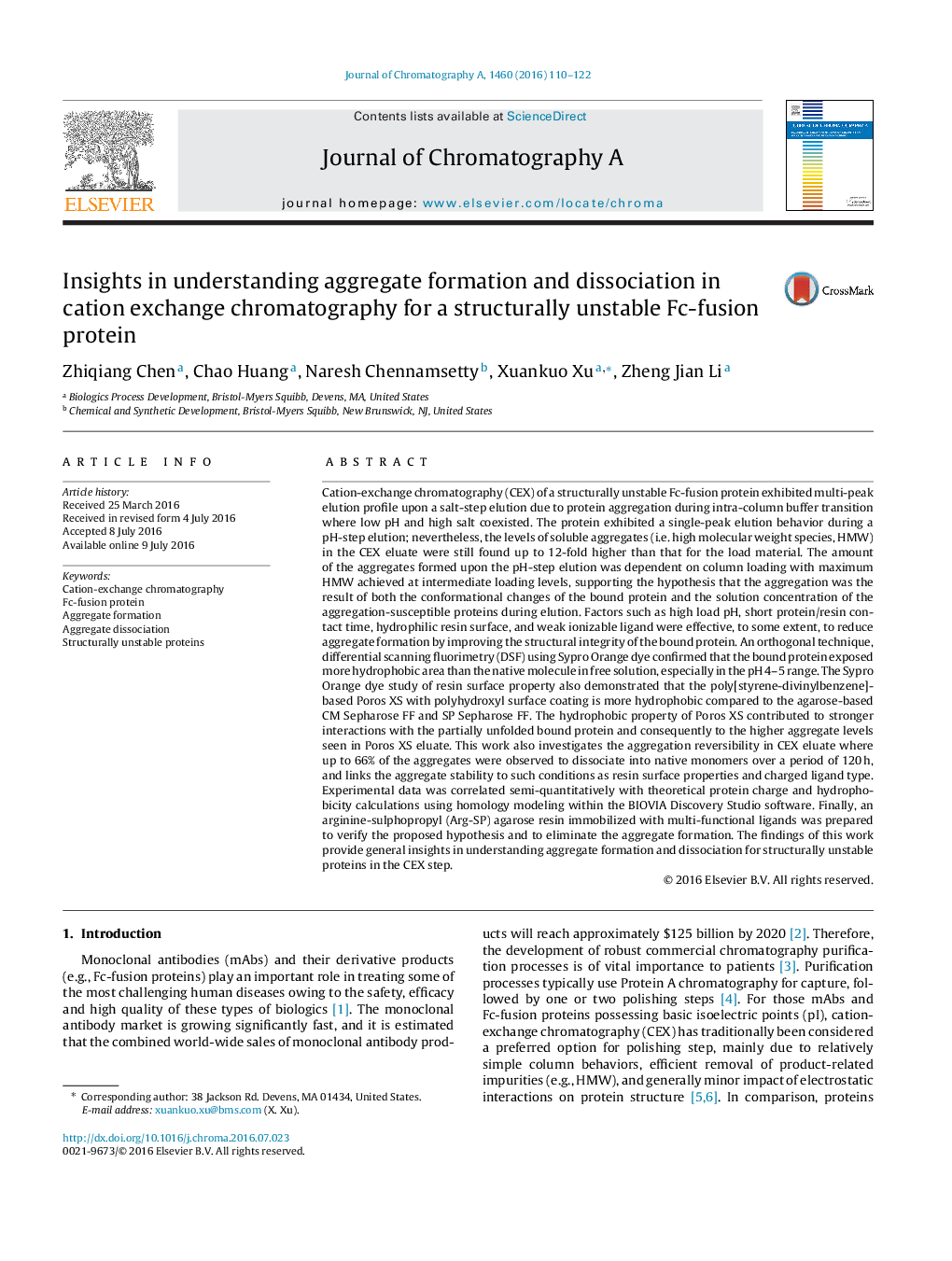| کد مقاله | کد نشریه | سال انتشار | مقاله انگلیسی | نسخه تمام متن |
|---|---|---|---|---|
| 1199988 | 1493466 | 2016 | 13 صفحه PDF | دانلود رایگان |

• Aggregation phenomena in CEX step were studied for a structurally unstable Fc-fusion protein.
• Conformational changes in bound protein affect eluate aggregate level and aggregation reversibility.
• Conditions that improve the structural integrity of bound protein help reduce aggregate formation.
• CEX resin hydrophobicity contributes significantly to protein-resin interactions for partially unfolded protein.
• An agarose resin immobilized with multi-functional ligands was prepared to verify the proposed hypothesis.
Cation-exchange chromatography (CEX) of a structurally unstable Fc-fusion protein exhibited multi-peak elution profile upon a salt-step elution due to protein aggregation during intra-column buffer transition where low pH and high salt coexisted. The protein exhibited a single-peak elution behavior during a pH-step elution; nevertheless, the levels of soluble aggregates (i.e. high molecular weight species, HMW) in the CEX eluate were still found up to 12-fold higher than that for the load material. The amount of the aggregates formed upon the pH-step elution was dependent on column loading with maximum HMW achieved at intermediate loading levels, supporting the hypothesis that the aggregation was the result of both the conformational changes of the bound protein and the solution concentration of the aggregation-susceptible proteins during elution. Factors such as high load pH, short protein/resin contact time, hydrophilic resin surface, and weak ionizable ligand were effective, to some extent, to reduce aggregate formation by improving the structural integrity of the bound protein. An orthogonal technique, differential scanning fluorimetry (DSF) using Sypro Orange dye confirmed that the bound protein exposed more hydrophobic area than the native molecule in free solution, especially in the pH 4–5 range. The Sypro Orange dye study of resin surface property also demonstrated that the poly[styrene-divinylbenzene]-based Poros XS with polyhydroxyl surface coating is more hydrophobic compared to the agarose-based CM Sepharose FF and SP Sepharose FF. The hydrophobic property of Poros XS contributed to stronger interactions with the partially unfolded bound protein and consequently to the higher aggregate levels seen in Poros XS eluate. This work also investigates the aggregation reversibility in CEX eluate where up to 66% of the aggregates were observed to dissociate into native monomers over a period of 120 h, and links the aggregate stability to such conditions as resin surface properties and charged ligand type. Experimental data was correlated semi-quantitatively with theoretical protein charge and hydrophobicity calculations using homology modeling within the BIOVIA Discovery Studio software. Finally, an arginine-sulphopropyl (Arg-SP) agarose resin immobilized with multi-functional ligands was prepared to verify the proposed hypothesis and to eliminate the aggregate formation. The findings of this work provide general insights in understanding aggregate formation and dissociation for structurally unstable proteins in the CEX step.
Journal: Journal of Chromatography A - Volume 1460, 19 August 2016, Pages 110–122